Interested in learning how to start a Gut Healing Bullet Journal via a minimalist bullet journal daily spread?
Well, this is what I’m going to teach you how to do today.
What is a Bullet Journal?
The traditional Bullet Journal is a rapid way for logging information.
It makes journaling easy and accessible for anyone and completely customizable.
A bullet journal is a great way to track all of the different areas of your life, or just to log important tasks and goals. It is ultimately up to you how you want to use it.
All you need is a blank journal and a bit of guidance on how to optimize your journal.
Why Start a Gut Healing Bullet Journal?
There are so many reasons I would recommend starting a gut healing bullet journal. This is a great thing to have in your back pocket for tracking different protocols or just how your gut behaves on a daily basis.
Here are some of my favorite ways to use my gut healing bullet journal:
- Help track your Elimination Diet
- Track doctor’s visits
- Make correlations between food and mood
- Have a way to simply record your day-to-day without feeling overwhelmed by sitting down for 10+ minutes to journal
- Learn new things about yourself
- Learn new things (in general)
- Have easy-to-find information for doctor’s appointments
- Realize quickly what does/does not work
- Track different habits and how they impact your gut
- Brain dumps for emotionally difficult days
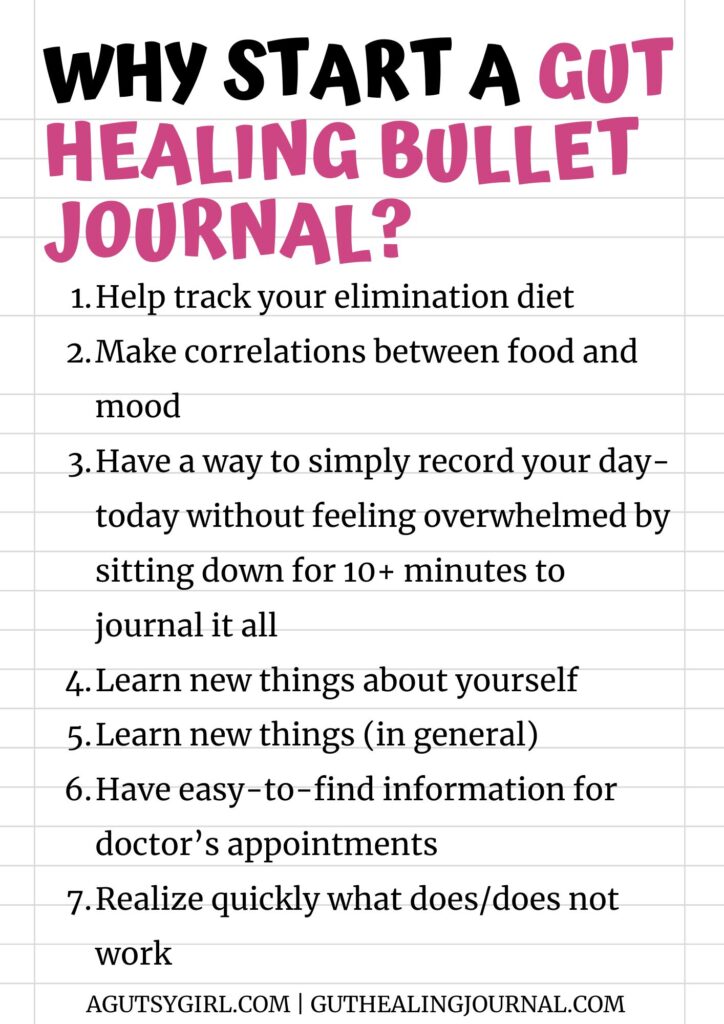
Minimalist Bullet Journal Daily Spread
Click HERE to save this post on the Minimalist Bullet Journal Daily Spread for later.
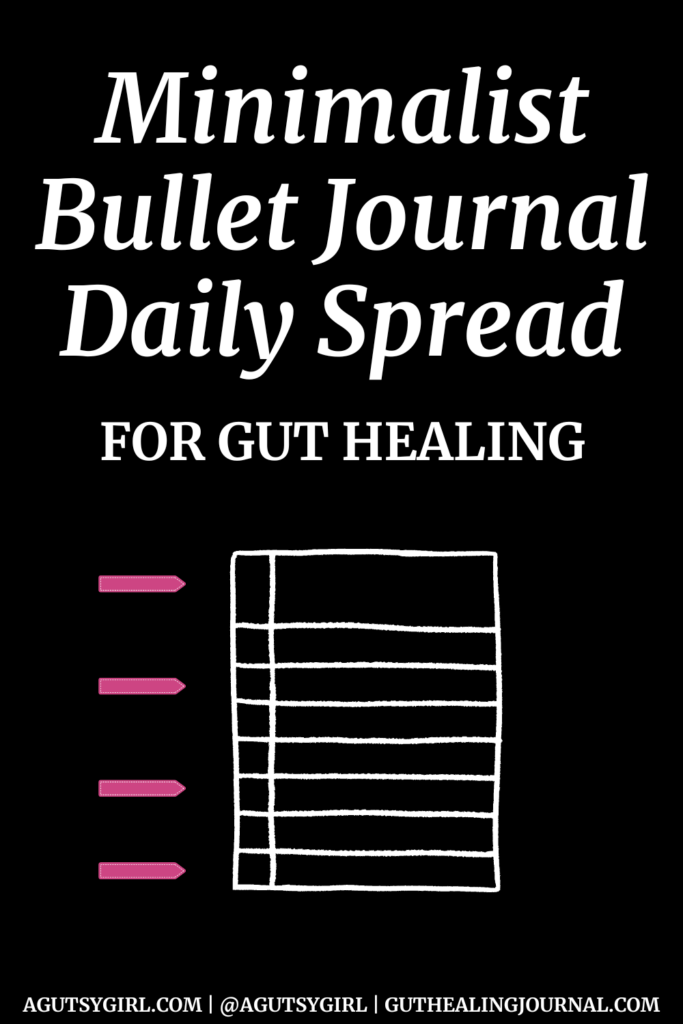
Luckily it is SO SO easy to start your own bullet journal.
It is such a fun way to get all of you s*#$ together….and you can do so with a minimalist approach.
Get a journal.
Grab a journal with as many or little pages as you’d like.
The first one I had was 158 pages (which lasted about 3 months).
Then I had one with 240 pages.
Your journal doesn’t need to be anything fancy. It just needs to be useful.
I recommend picking one that has blank pages or dots, to keep it as customizable as possible with a simple layout.
I know the ones I created, the 28-day + 90-day gut healing journals are useful and the best way to journal in a simple way for your gut healing journey (+ quick answers!).
And it’s done and ready for you. If you like this post, but don’t want to DIY your Bullet Journal, just grab mine.
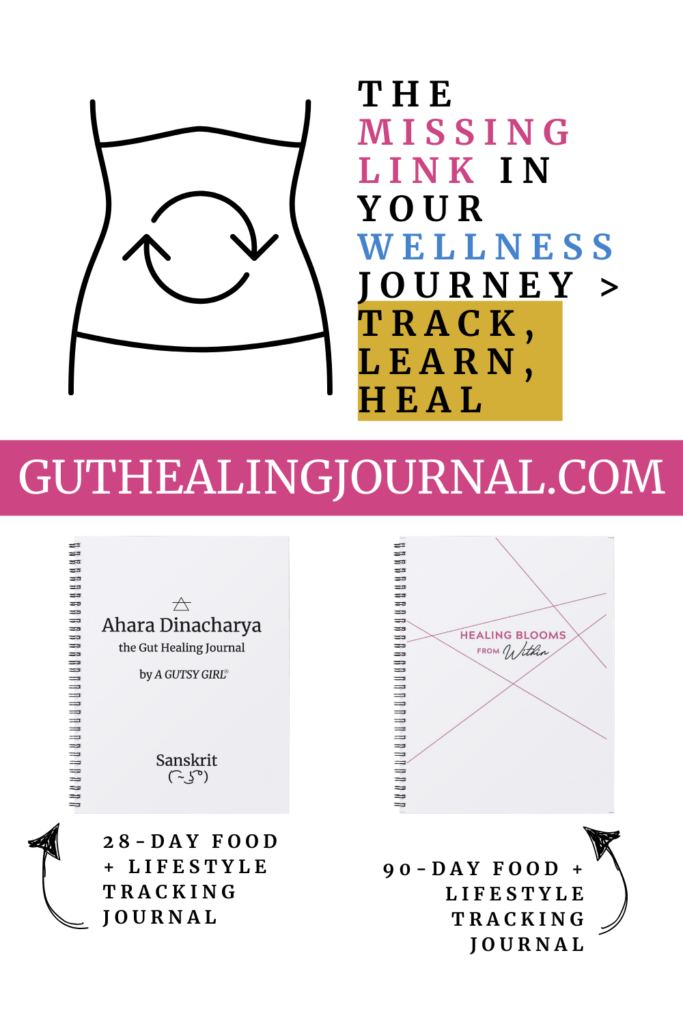
Number all the pages.
The very first thing you should do when you get your journal is number all pages.
Place the numbers on the lower right or left-hand corner of each page.
Index.
Page 1 will be your Index, so write “Index” at the top of the page.
This is where you can correlate each daily spread with the page number.
Decide all the various pieces you want to make up your Gut Healing Bullet Journal
Between my old one and new one, some of my pieces include: Key (non-negotiable), Bristol Stool Chart, supplements, reintroduction + questionable, journaling pages, variations of my AIP Bread recipe, Low-FODMAP + SCD master food lists and monthly calendar overviews.
I also recently have added a super simple habit tracker, which have been an absolute game-changer.
Other ideas include:
- daily tasks
- brain dump and motivation quotes page, little quotes can go a long ways for your journey
- sleep tracker
- daily schedule
The next page (or in my case 3rd page) should be your Key
My Key is fairly extensive because I like to be detailed in my notes and entry points (so I can easily find things).
This is an example of a key you could keep.
You’ll notice that some of them are from the standard Bullet Journal, but many are unique for a Gut Healing Bullet Journal:
KEY
- – statement
- . task to complete
- x task completed
- ! inspiration signifier
- M medicine
- S supplement
- w workout + steps
- H HCL and/or ACV
- * important, find quickly
- B beverage
- F food
- G symptoms
- BM bowel movement
- (arrow) explore – needs further research
- R reintroduction
- D diary entry
- SL sleep
- N new thing added
- CD cycle days
- P play, no stress, all joy
Make note: In the full journal I offer for purchase, Healing Blooms from Within, there is a full, comprehensive journal key conducive for gut healing that has a perforated edge, so you can tear it out for daily use next to your daily pages.
The next several pages should be dedicated to the various pieces you wrote down in step #4
So for me, page 4 is the ‘Bristol Stool Chart.’
Page 5 are ‘Supplements.’
Page 6 is ‘Reintroduction + Questionable.’
Continue on until your standard/static pages are complete.
Begin your official journaling pages.
Mine start on page 11.
At the top of the page, it says, “SCD + FODMAP + NO ANTIBIOTIC” then the date, followed by my day of Gut Healing Bullet Journaling.
Make note that not all of the standard/static pages need to be placed before your journal.
If it makes sense, place some of them at the end of the journal. For example, my Low-FODMAP + SCD master food lists and monthly calendar overviews don’t begin until page 227 in this example journal.
Pages I Recommend In Your Journal
There are some Minimalist Bullet Journal Daily Spread pages I would 100% recommend including in any gut-healing journal.
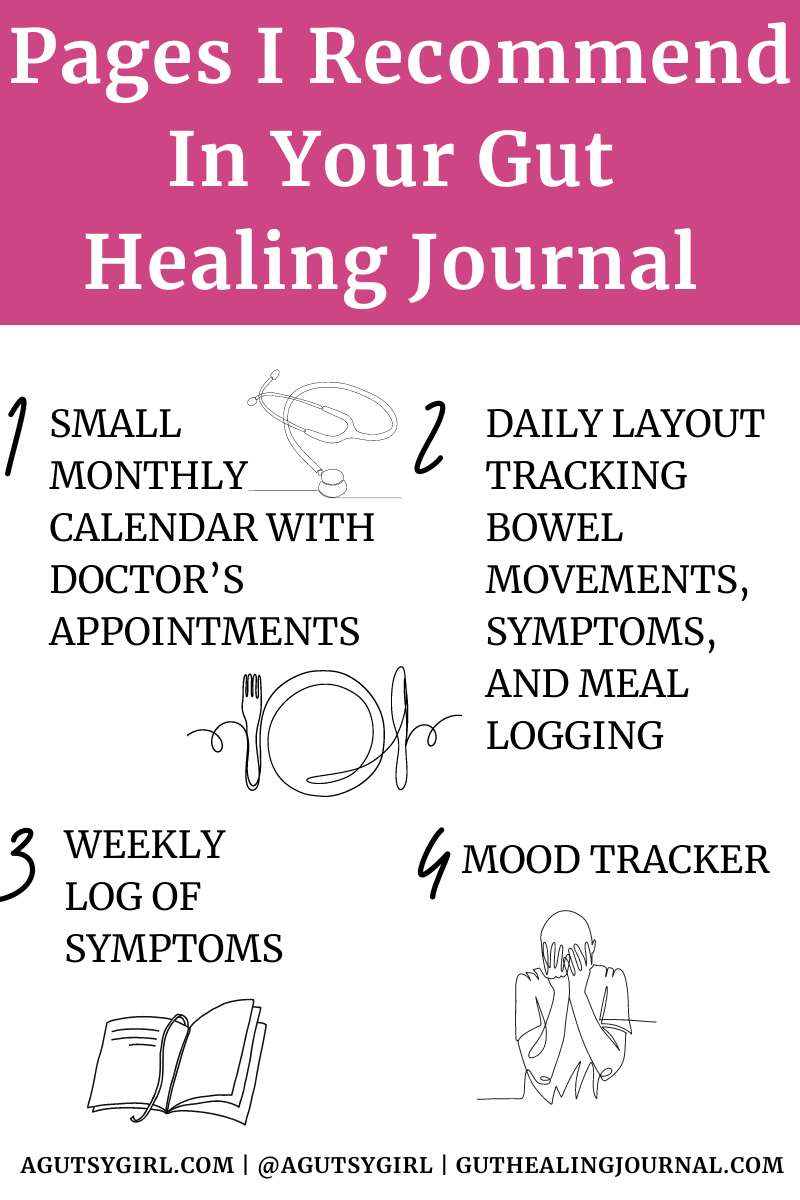
1. small monthly calendar with doctor’s appointments
I think this is an easy and simple way to keep track of any of your scheduled appointments via a monthly log of sorts.
It can also help you have time to prepare for each appointment and make specific notes in the days leading up to it.
2. daily layout tracking bowel movements, symptoms, and meal logging
This is a great idea for keeping track of all of your supplements, foods, and symptoms each day. You make one for every one of the days of the week and include all the information that can play a role in your gut symptoms.
This includes foods, supplements, and exercise. Clearly tracking all of these on a day to day basis may help you better find connections you haven’t noticed before.
3. weekly log of symptoms
I like to rank my overall gut on a scale 1-10 each day and create a page where I can see the average score across each week.
This helps me to better see if there is a correlation between what I do throughout the weeks, and if any progress, even slow, has been made.
4. mood tracker
This is a HUGE deal for any type of gut issue due to the gut-brain axis. Our emotions and moods can have a huge impact on our day-to-day activities, gut and everything in between.
This is especially big for all my anxious Gutsy girls out there.
Seeing the correlation between gut issues and anxiety flare-ups can be extremely helpful.
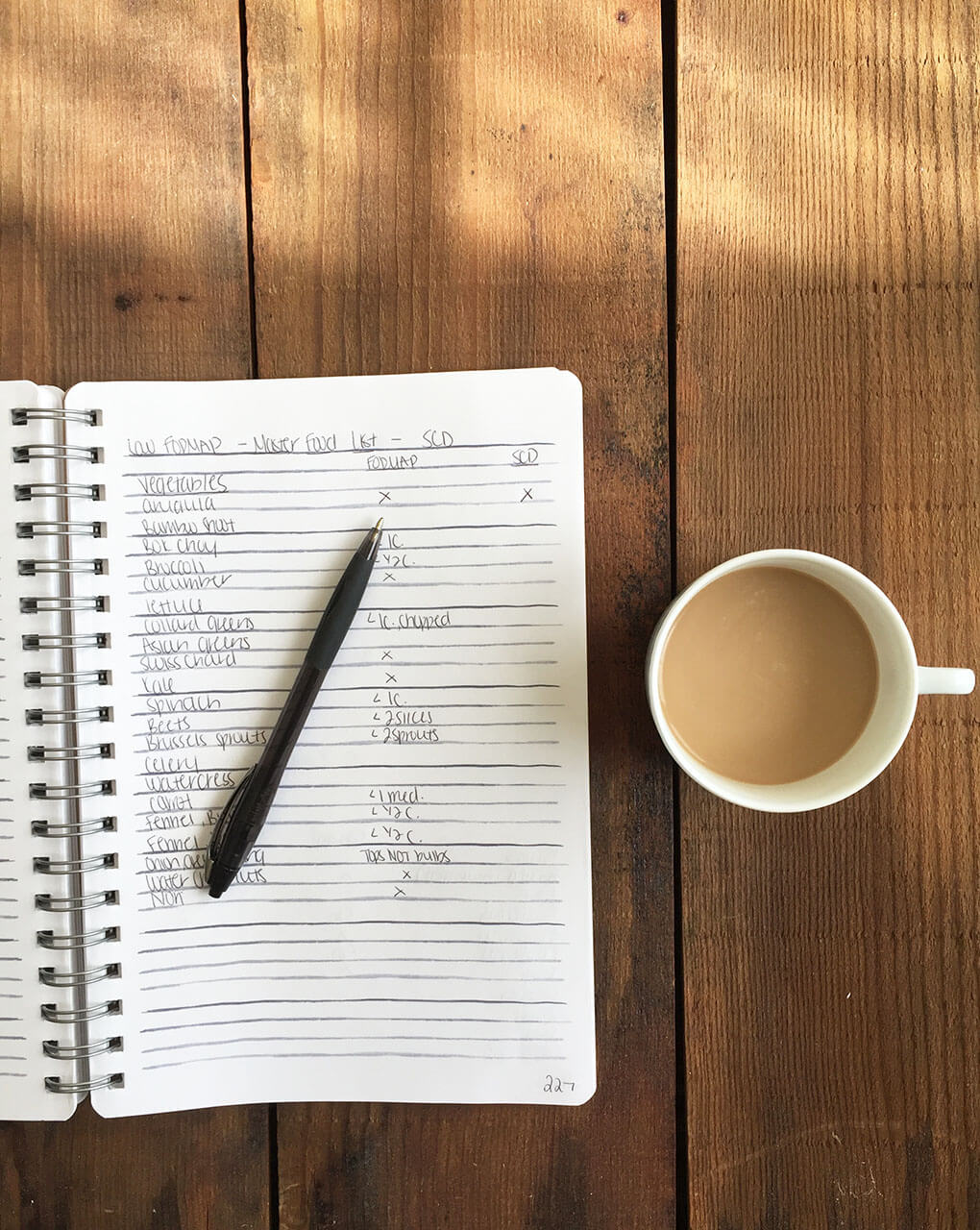
How I Like To Style My Journal
Now, this part is completely optional, but I personally love making my journal pretty to look at.
This helps keep me motivated to continue tracking and looking at it each day.
This is totally up to personal preference how much you want to add to your journal.
If you are a complete beginner, you may just want to keep everything nice and simple and that’s perfect too.
Even just some fun pen colors and easy stickers can elevate your journal to the next level.
You can also play around with washi tapes and hand lettering for an even more aesthetic style.
If you want to keep it super simple with a lot of white space, HERE are some minimalist designs I really like.
I have found a lot of the minimalistic spreads to be the most realistic for me to do.
In reality, some of the more complicated spreads can take a lot of time that I simply don’t have.
So for now, I personally opt for the simple spread.
Obviously you can make it as complicated or simple as you like, but I like to find my inspiration on Pinterest.
If you type in “bullet journal ideas” there is a whole bullet journal community that can really get you started.
Overall Bullet Journal Tips from a Minimalist Standpoint
Obviously you don’t want your journal to be a mess, so here are some tips I have learned along the way for quickly making it look neat.
1. prioritize those clean lines
Clean lines on any spread can make or break the entire journal. Use a ruler or a straight edge to really keep your journal looking good.
2. the minimalist style can be your best friend
Especially for beginners, these spreads are very doable and easy to master. I would recommend starting a simple bullet journal and then building from there.
3. take it day by day
You don’t need to build your entire bullet journal in one day. I would personally start off just by making a monthly spread, some daily logs, and a couple of my recommended pages.
Start small so you don’t overwhelm yourself right from the start. Plus, you want to find what set ups you like the best before committing to an entire journal.
4. perfection is not attainable
Now for all my type A people out there, you know who you are, don’t hold yourself to crazy standards here. Its a journal at the end of the day, not a display of artistic skills.
If you mess up, move on and remember what the actual purpose of a Minimalist Bullet Journal Daily Spread is for.
Healing. Your. Gut.
Other Tools
Here are some tools that I use when bullet journaling. This does not mean you need all of these for a successful bullet journal, but I find them to be helpful.
- black ink pens
- colored pens
- pastel highlighters
- ruler for making straight lines
- washi tape
- magazine cut outs
- calligraphy pens
My own artistic skills are still in the works, but I find these to be helpful for making my journal cute and easy to read.
Remember, you’ll find all of the above and more via the Master Gutsy Spreadsheet.
Some Bonus Things for Your Gut Healing Bullet Journal
You will likely not have the time to watch this whole video, but check out all the creativity that Boho Berry has in her Bullet Journal.
No, this is not a Gut Healing Bullet Journal and our journal content would and will look very different, but the points are these:
- Creativity rocks. After watching the video, I got out my colored pencils and started coloring on the cover of my journal. (If you have my 90-day journal, there is even a page to make a mini vision board.)
- Evolve. I have only been doing this since February, and already my journals have evolved. As you heal (or have a setback), the way you go about this might change. That’s okay. In fact, that’s encouraged.
- New ideas, tailored for you. Boho Berry has some cool ideas (i.e. her ‘Habit Tracker,’ which is something I was trying to figure out a way for doing). Is there anything you can take and tailor to gut healing?
If I’ve said it once, I need to say it again.
Gut healing is about more than food.
In fact, I have learned that it might be 80% “other” + 20% food when it comes to real, long-lasting and true healing.
Dig deeper on your own gut healing journey to learn more, explore and get the most out of your own gut healing.
And remember, if you’d rather skip this whole process and have one of these done for you, then grab Healing Blooms from Within HERE, the 90-day gut healing journey system I created based off all this and more.
It is a super easy journal that has all of this premade and ready to go.
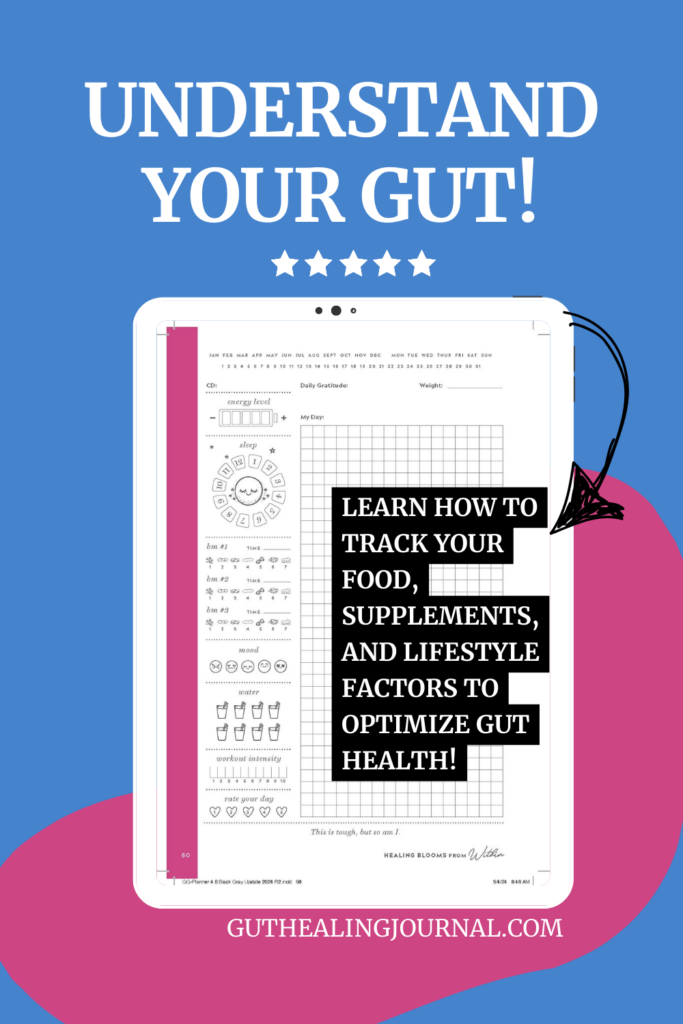

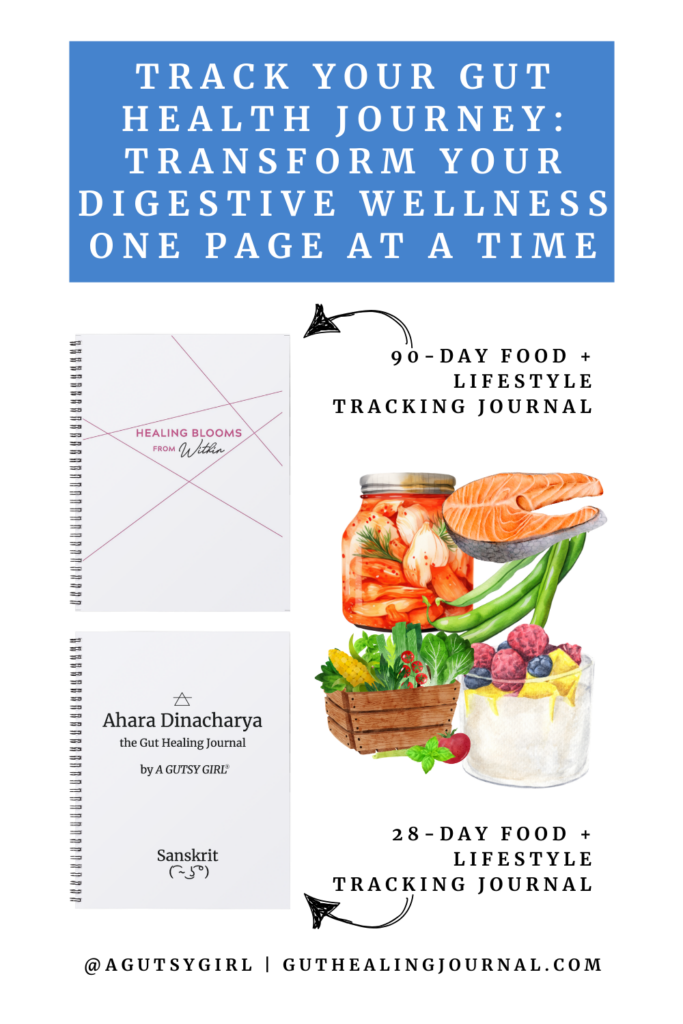
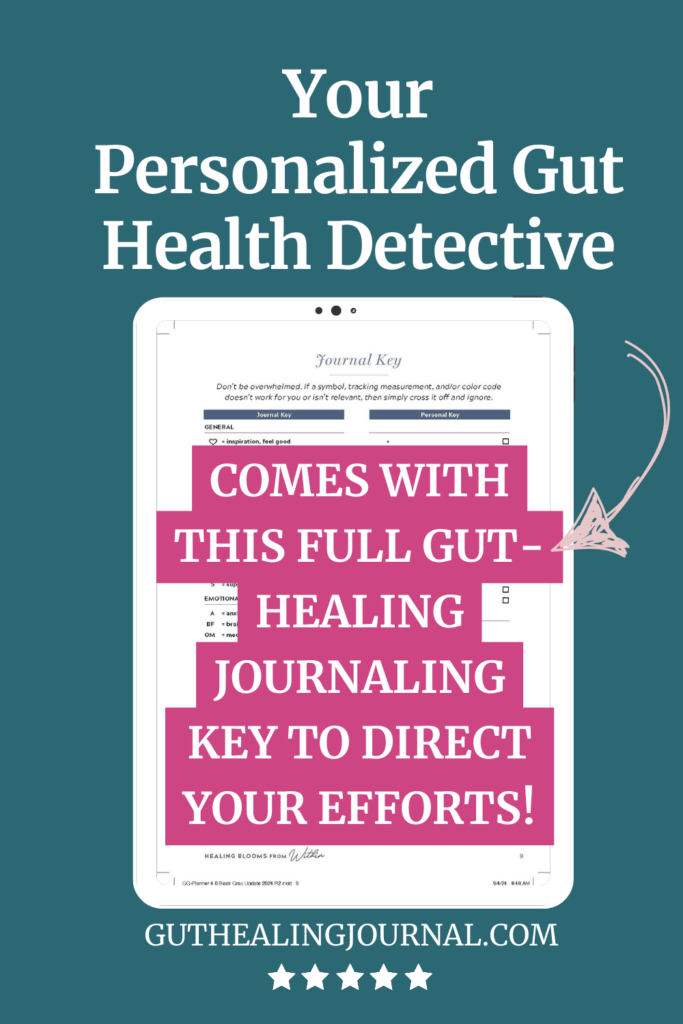
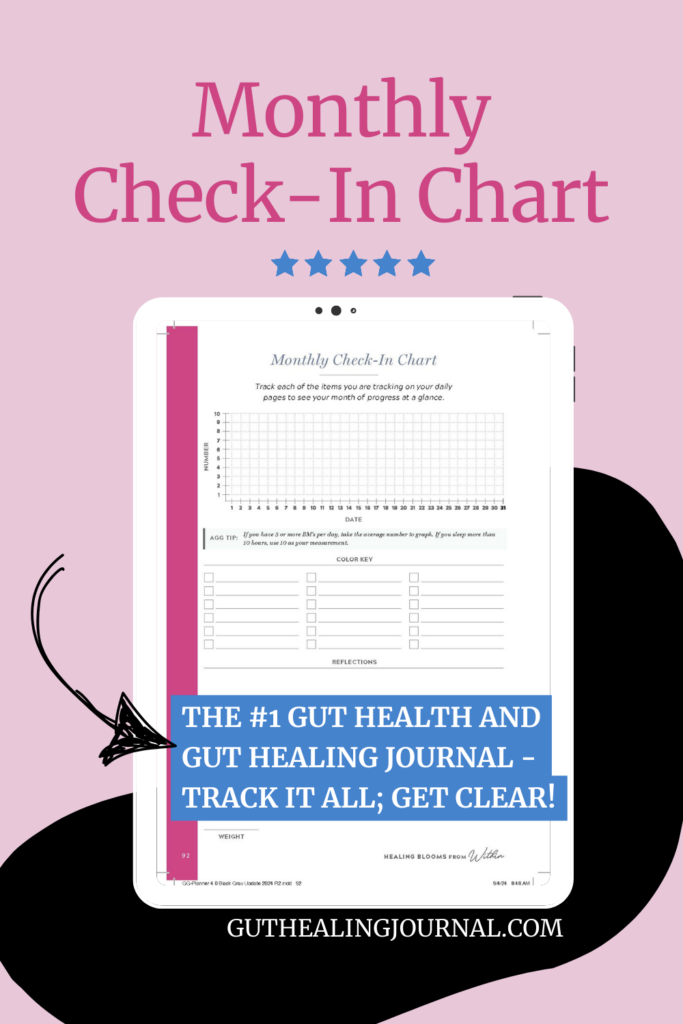
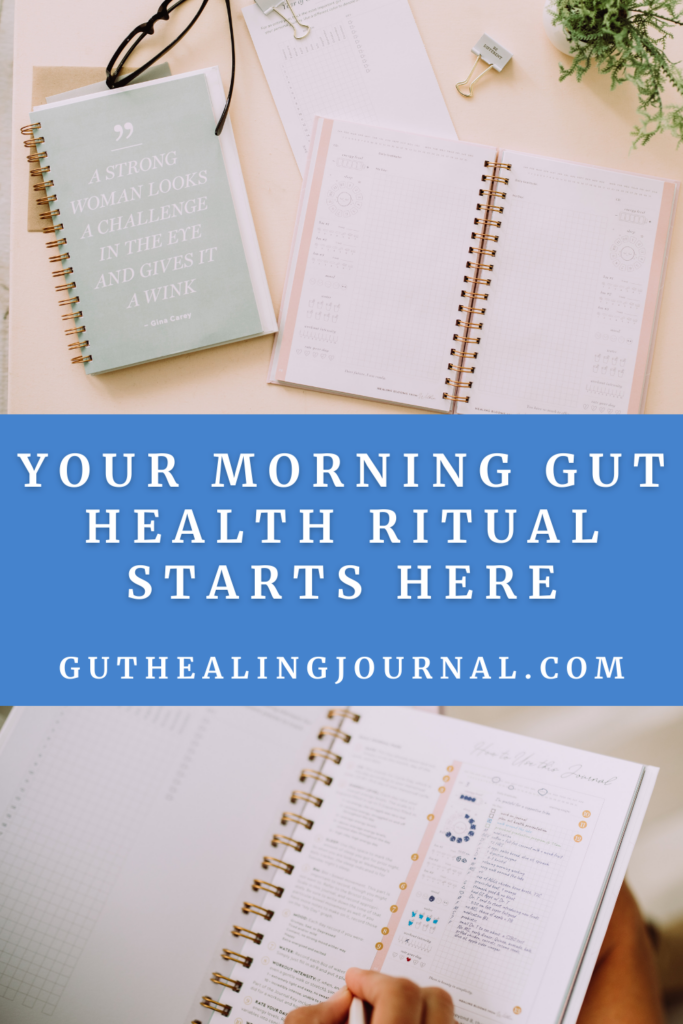
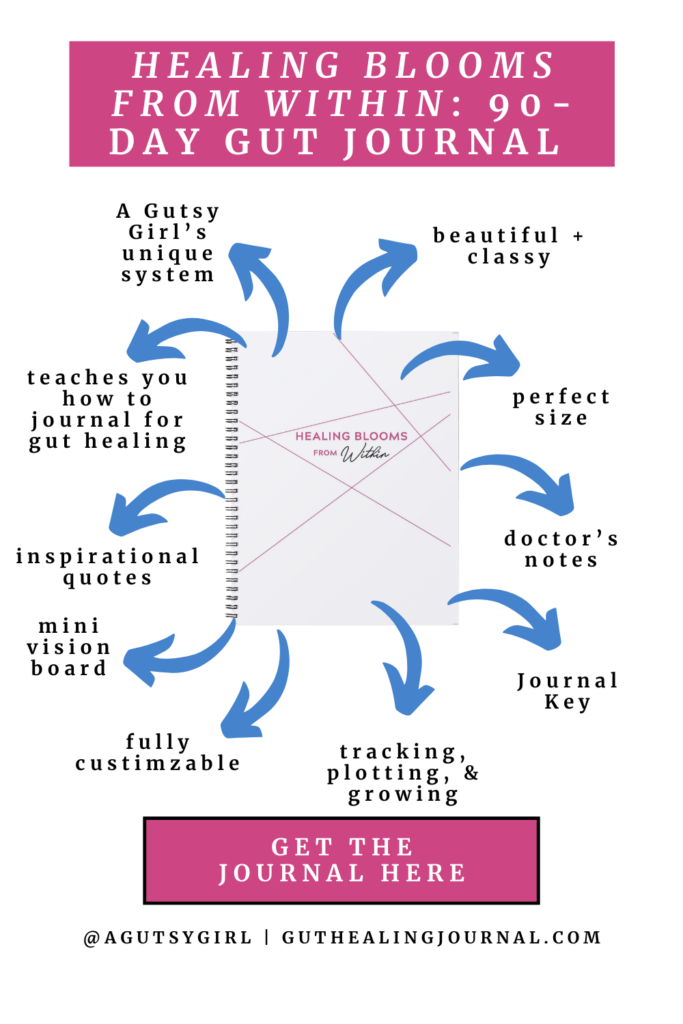
If you liked this post on how to create a Minimalist Bullet Journal Daily Spread, you might also enjoy:
- A Gutsy Girl’s Bible
- Minimalist Approach to Gut Healing Supplements
- Stop Making This One Food Journaling Mistake
Xox,
SKH
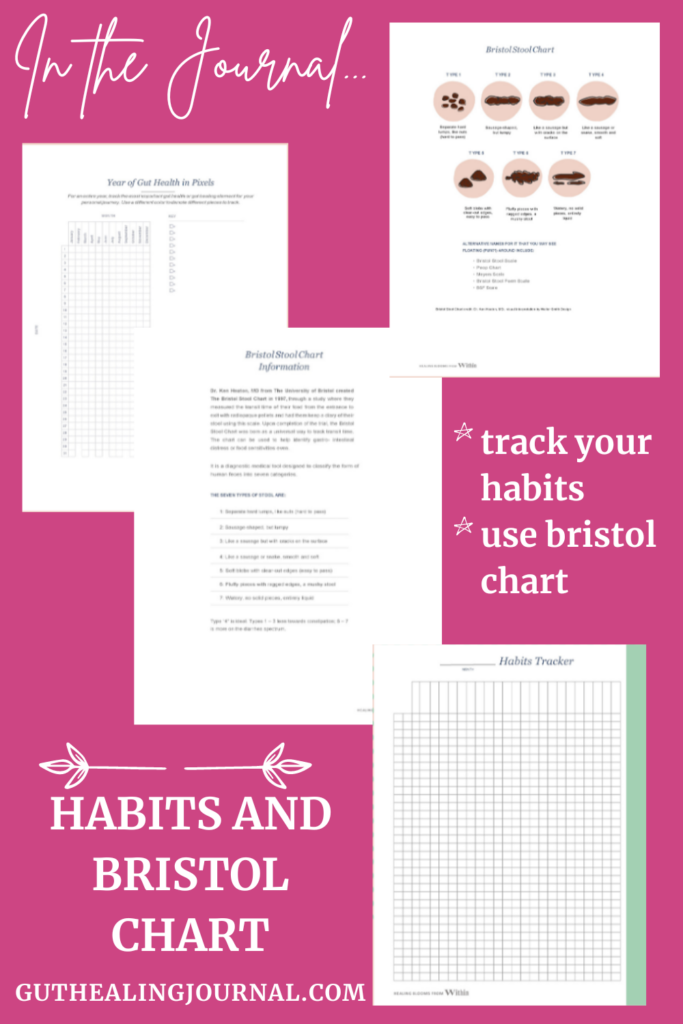
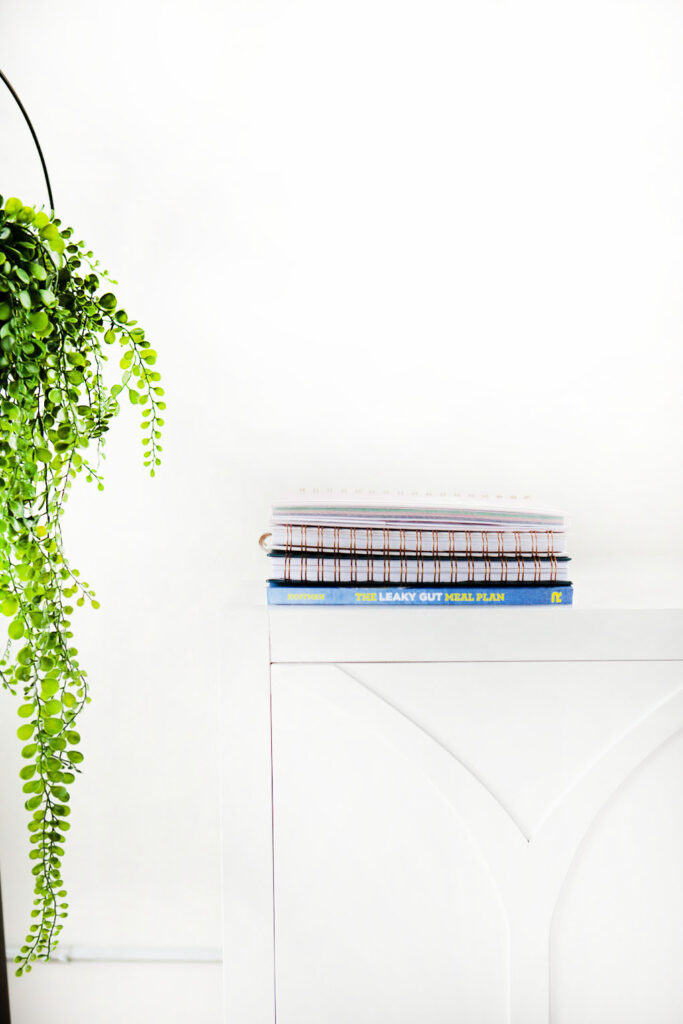
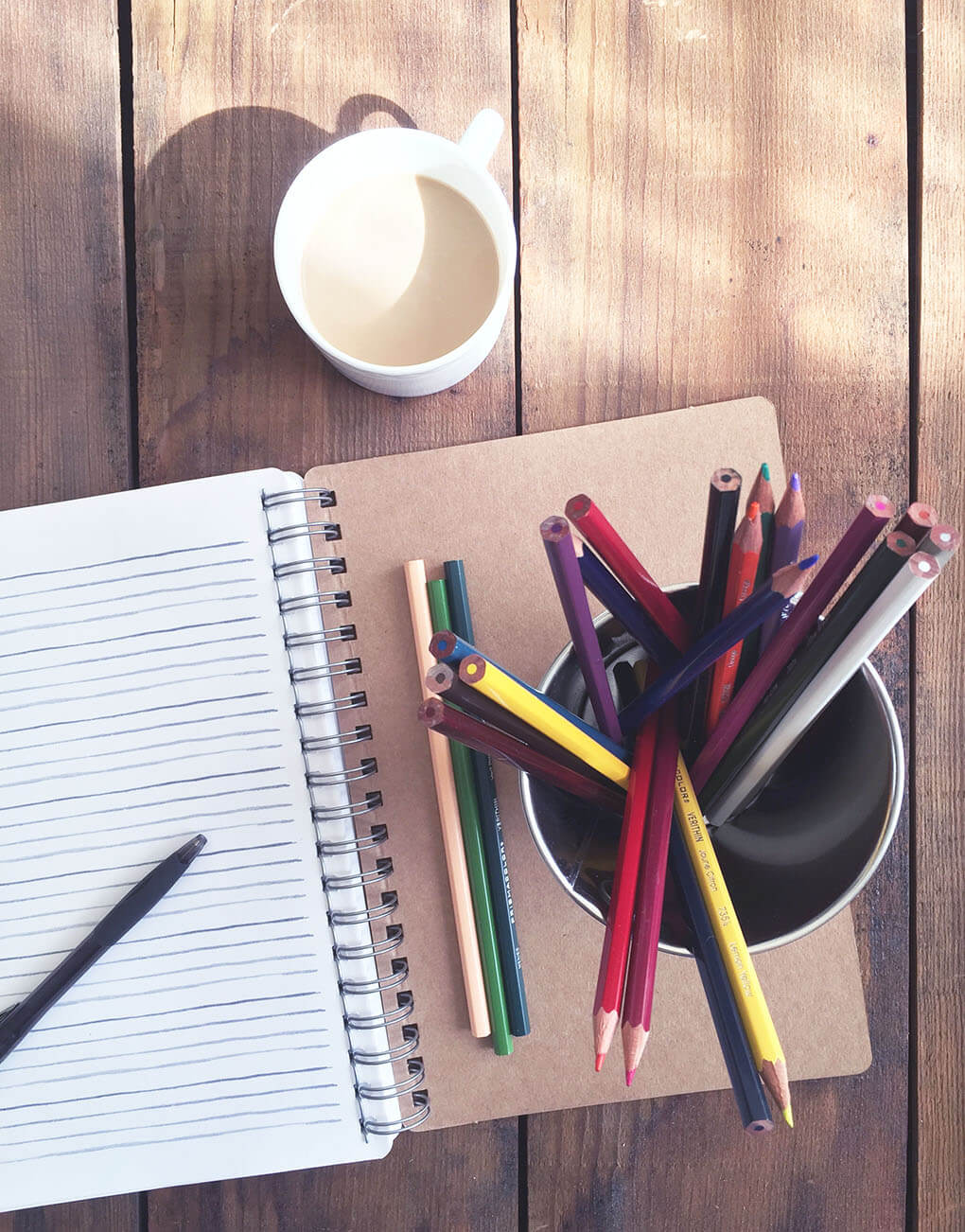
🤰 bloating be gone! weight loss through optimal gut health for women
💃ʜᴇᴀʟ ʏᴏᴜʀ ɢᴜᴛ. ʜᴇᴀʟ ʏᴏᴜʀ ʟɪfe.
🫶🏻 founder gutbyome.com

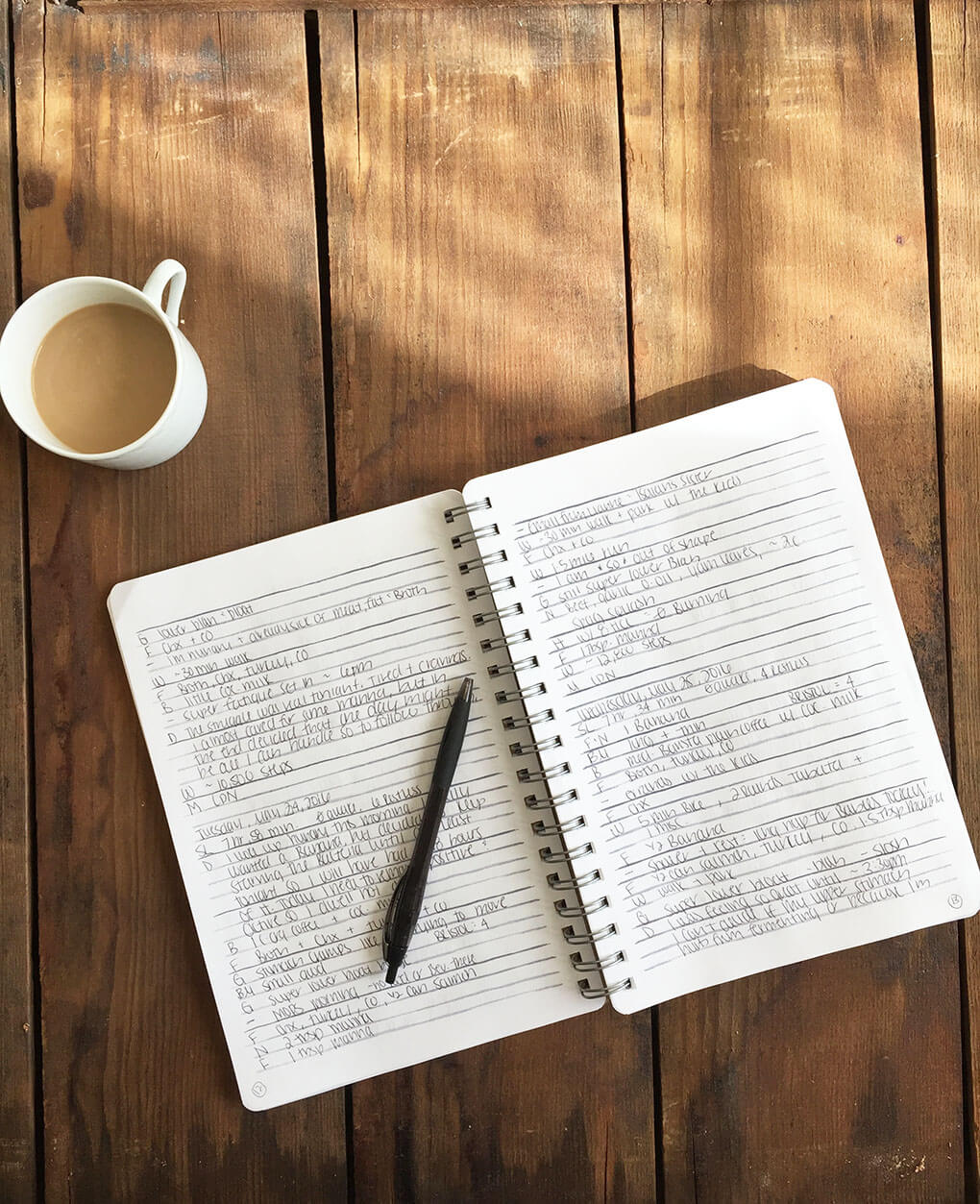
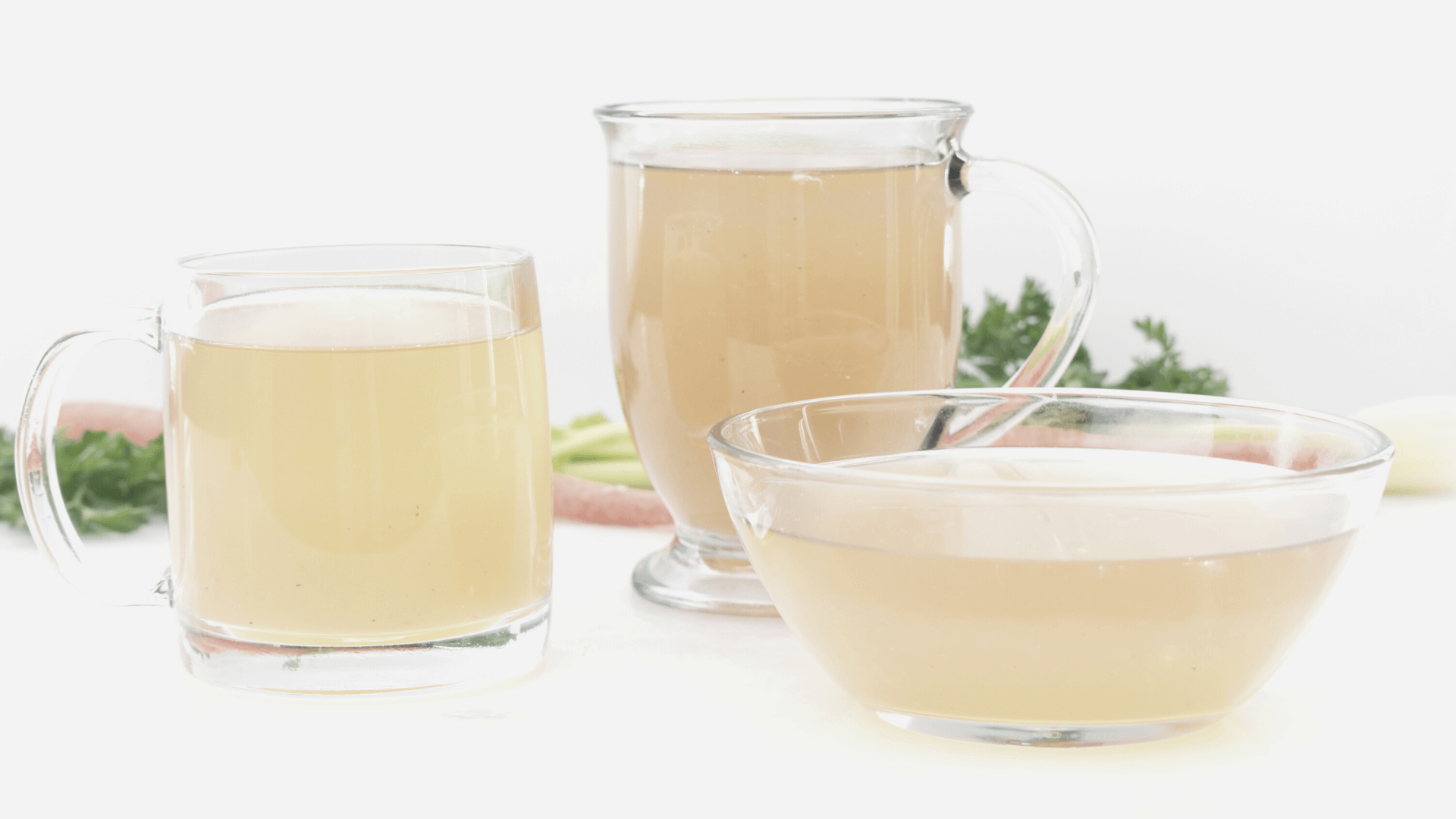

![What is Ayurveda – [The Ultimate Beginner’s Guide]](https://agutsygirl.com/wp-content/uploads/2024/10/ayurveda-featured.png)
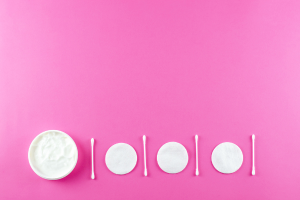


I don’t keep a journal for my gut specifically, but I did add a section to my normal general purpose bujo (or whatever you want to call it) to keep track of my elimination diet and it helped so much when it comes to sticking with it. It’s already hard enough to stick with such a strict diet, and if you aren’t writing down how different you feel emotionally or physically it’s easy to start thinking that sticking with it isn’t worth the trouble.